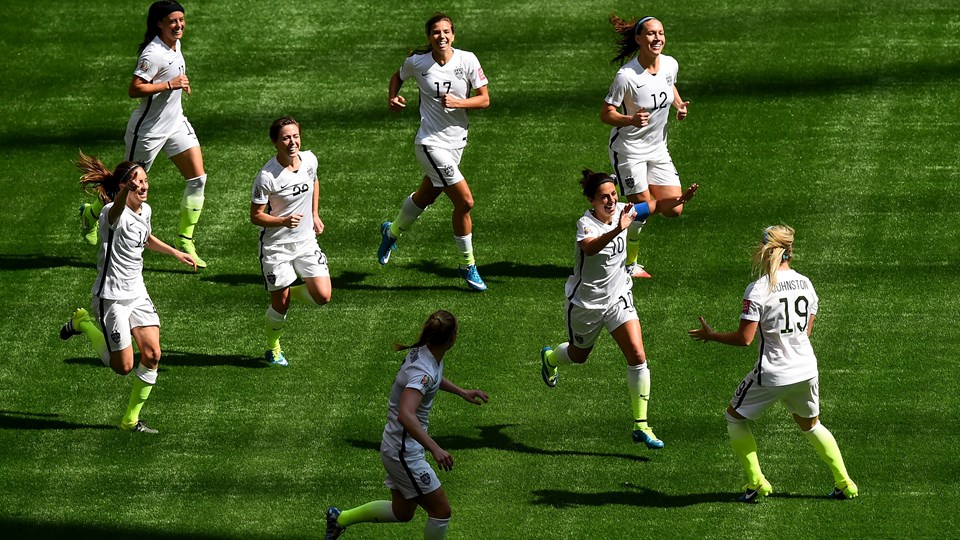This essay was published in the July 19, 2015 edition of the Lancaster (PA) Sunday News We’re two weeks removed from the World Cup victory of the U.S. Women’s National Team, and a week past the 2015 U.S. Women’s Open in Lancaster.
In both tournaments, the competition was compelling and the brilliance of these world-class athletes was inspiring.
Predictably, an all too familiar conversation around women’s athletic events resurfaced. In the case of the women’s soccer team, the discussion centered on whether the World Cup victory will have a long lasting impact on the growth of the sport, particularly as it relates to the long-term viability of a women’s professional soccer league. And in the case of the US Open, the continued disparity of media coverage, sponsorships and financial support as compared to the men’s pro golf tour was highlighted.
In both cases, the issue at the crux of the debate ultimately relates to whether the commercial appeal of women’s sports will ever be on par with the men.
The short answer? Probably not.
But that’s not all bad. In the case of athletics, mimicking the men is not always a good idea.
That said, there is absolutely no question the commercial appeal and impact of elite women’s sports is going to continue to grow in every way -- from media coverage, to funding, to improved talent levels to increased corporate sponsorships. Despite the fact that there are still major gaps in funding and support in high schools when it comes to sports teams for boys and girls, much of this growth will be a result of the ongoing accumulative effect of Title IX, which was adopted as part of the 1972 Education Act and designed to prohibit gender discrimination in federally funded education programs.
While Title IX has, and will continue to drive the growth and development of women’s sports, there is another, and ultimately more important, factor at work. Specifically, women are making significant gains across a wide swath of society. More women are graduating from college and thus are being provided opportunities to avail themselves of more varied and lucrative careers. Women are also beginning to have more influence in executive suites and corporate boardrooms, a trend that will surely escalate. As a result, women, as an important sports, television and corporate demographic, will grow.
Why is this significant?
Professional sports is driven and underwritten largely by the business community through television, corporate dollars and sponsorships. As women achieve more power, influence and decision-making authority in the executive suites and corporate boardrooms, the amount of corporate support for women’s sports will naturally increase. That support will translate to more money, resources, visibility and commercial viability. In short, women are assuming more economic power and advertisers and corporate sponsors are taking notice.
While such progress may not be as rapid or comprehensive as many would like, it’s clear that women’s professional sports are going to continue to grow in public awareness, economic clout and cultural impact.
That begs the question. How are we, as parents, coaches, administrators and educators going to manage that growth?
The core argument for Title IX centered on the issue of how beneficial involvement in sports is for young girls. It is clear that in addition to its obvious fitness benefits, such involvement builds self-esteem and teaches lessons in teamwork, disciple and personal responsibility. Sports, when kept in the proper perspective, can impact young people in tremendously varied and important ways. Sports can change lives.
So while its’ entertainment value is nice, sports’ most potent and valuable characteristics are its fitness, educational and character building potential.
But make no mistake, as the amount of visibility, money and corporate involvement rises, so too will the pressure to win, complete with all of its side effects. As has happened with men’s athletics, this pressure to win, which generates more money, visibility and cultural influence, will result in an increased pressure to “professionalize” sports at younger and younger ages. In other words, as professional sports become more lucrative and visible, the pressure to win and generate the money to support and exploit that system will flow downward. And as sports become more about the end product (winning and the potential for fame and fortune) they become less about the process (fitness and education).
Yes, it is important that we continue to fight for equality and opportunity at the professional level. But rest assured, given the growing power and influence of women in our society, those opportunities will eventually be realized. But that progress must be managed. That means we’ll have to fight even harder to keep at bay, the inevitable downward push of professionalizing sports at younger and younger levels. Ultimately, youth sports are not about developing the next US Open Champion, World Cup goalie or even earning a college scholarship, but rather about teaching, molding, growing and developing young girls to be the business and community leaders of the future.
So while we should celebrate our World Cup victory and admire the brilliance of the professional athletes who graced our community, let’s not forget where the real value of women’s and men’s sports lies – in the youth levels, as a fitness and educational tool.

